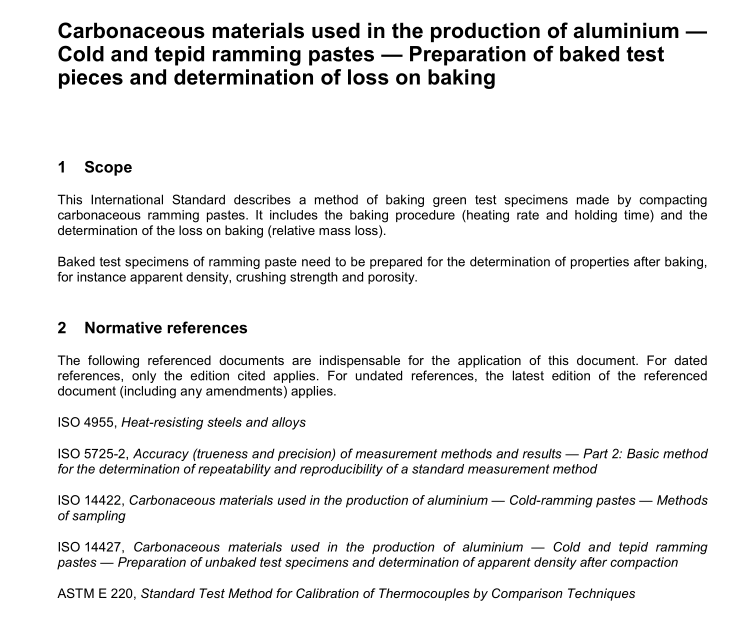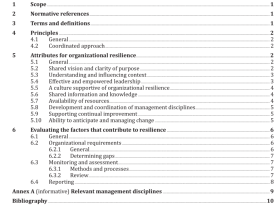ISO 20202 pdf download

ISO 20202 pdf download Carbonaceous materials used in the production of aluminium — Cold and tepid ramming pastes — Preparation of baked test pieces and determination of loss on baking
1 Scope
This International Standard describes a method of baking green test specimens made by compactingcarbonaceous ramming pastes. lt includes the baking procedure (heating rate and holding time) and thedetermination of the loss on baking (relative mass loss).
Baked test specimens of ramming paste need to be prepared for the determination of properties after baking.for instance apparent density, crushing strength and porosity.
2Normative references
The following referenced documents are indispensable for the application of this document.For datedreferences,only the edition cited applies. For undated references, the latest edition of the referenceddocument (including any amendments) applies.
ISo 4955,Heat-resisting steels and alloys
IS0 5725-2,Accuracy (trueness and precision) of measurement methods and results — Part 2:Basic methodfor the determination of repeatability and reproducibility of a standard measurement method
ISO 14422,Carbonaceous materials used in the production of aluminium — Cold-ramming pastes — Methodsof sampling
ISO14427,Carbonaceous materials used in the production of aluminium — Cold and tepid rammingpastes—Preparation of unbaked test specimens and determination of apparent density after compaction
ASTME 220, Standard Test Method for Calibration of Thermocouples by Comparison Techniques
3Principle
Compacted test specimens of carbonaceous ramming paste are baked in a furnace by raising the temperatureat a specified rate to 1 000 °C and holding the temperature at this value for 2 h.’ The mass of each testspecimen is measured before and after baking and the loss on baking calculated.
4Apparatus
4.1Balance, accurate to 0,1 g.
4.2Furnace,e.g. an electrically heated muffe furnace or chamber furnace,with a temperature-controlfacility enabling it to meet the requirements given in Clause 6.
4.3 Baking container with cover, capable of holding the test specimens and made from heat-resistant steel (e.g. X15CrNiSi2521 steel as specified in ISO 4955). The distance between th
e test specimens and between the test specimens and the container walls shall not be less than 10 mm. An example of a suitable container is shown in Figure 1. 4.4 Packing material, consisting of electrographite or calcined petroleum coke, maximum particle size 1 mm. 4.5 Temperature-measuring device, capable of determining the temperature to within ± 5 °C up to 1 000 °C, e.g. a type K or S thermocouple calibrated in accordance with ASTM E 220.
5 Sampling Sample the paste in accordance with ISO 14422. Prepare the test specimens in accordance ISO 14427. 6 Procedure Determine the mass m 0 of each unbaked test specimen to the nearest 0,1 g. Insert the test specimens in the baking container (4.3). Surround the test specimens on all sides by at least 10 mm of packing material (4.4). Insert the container, with its cover fitted, into the furnace (4.2). Heat the furnace in accordance with the heating programme given in Table 1.
Keep the furnace at a final temperature of (1 000 ± 10) °C for 2 h to ensure that all the test specimens reach this temperature. Then allow the furnace to cool down to room temperature. Take the test specimens out of the baking container. Remove any packing material which may be sticking to the surface of the test specimens. Determine the mass m 1 of each baked test specimen to 0,1 g.
7 Expression of results Calculate the relative mass loss during the baking process, called the loss on baking, using the following equation:
8 Precision (determined in accordance with ISO 5725-2)
Repeatability (r) = 0,9 % (absolute)
Reproducibility (R) = 2,3 % (absolute)
The number of degrees of freedom, i.e. number of laboratories (6) × number of samples (4), was 24.
NOTE The precision will be influenced by variability in the material.
9 Test report
The test report shall include the following information:
a) a reference to this International Standard;
b) all details necessary for identification of the sample tested;
c) the temperature used for preparation of the green test specimens;
d) the results of the test, i.e. the loss on baking;
e) the date of the test;
f) details of any unusual features noted during the determination;
g) details of any operation not included in this International Standard or regarded as optional.









